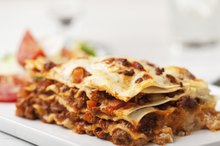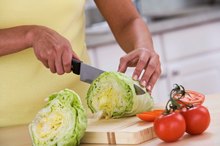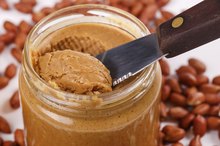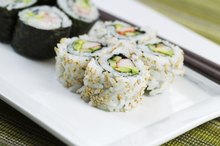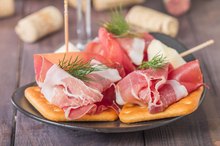Grocery List for Low-Fat & Low Calorie Foods
For people trying to lose weight, it is always better to prepare foods at home. But preparing foods at home means there needs to be a variety of healthy, low-fat, and low-calorie foods to choose from. Because there are so many choices at the supermarket, selecting the right foods to bring home may sometimes be difficult. Make this an easier process by having a list with you when you buy groceries.
Fruits and Vegetables
Fruits and vegetables are naturally low in fat and calories. Fresh and frozen vegetables without added sauces and fresh and unsweetened canned fruits are the best choices. The American Heart Association recommends buying a variety of colorful fruits and vegetables such as broccoli, carrots, strawberries and spinach, because these foods have a higher nutrient content 2.
Milk, Cheese, Butter and Eggs
Calories in Meat Lasagna
Learn More
Foods found in the milk, cheese, butter and eggs section of the grocery store can be a source of calories and fat. Low-fat and fat-free milk and cheese products are recommended when limiting fat and calorie intake. Good choices include skim milk, fat-free, no sugar added yogurt, and fat-free cheese.
One whole egg contains about 70 calories. People can buy eggs and save calories and fat by eating the egg white only, which only has about 25 calories. Instead of butter, choose light, soft tub margarine to reduce calories and fat.
- Foods found in the milk, cheese, butter and eggs section of the grocery store can be a source of calories and fat.
- People can buy eggs and save calories and fat by eating the egg white only, which only has about 25 calories.
Meat, Poultry, Fish and Nuts
When it comes to choosing meat, lean cuts are the better choice because they are lower in calories and fat. Lean meats include beef eye of round; pork tenderloin; veal cutlet; lamb shank; extra-lean ground beef; white meat poultry products without the skin; 95 to 99 percent fat-free luncheon meats; fish and shellfish; tuna packed in water; tofu; and low-fat peanut butter.
Bread and Baked Goods
Calories in a Subway Veggie Patty Sandwich
Learn More
Most breads are naturally low in fat, but high fiber whole-grain breads are the healthier choice, according to the American Heart Association 2. Light breads, containing about 40 calories a slice, are also available to reduce calories. Most processed baked goods, such as doughnuts, cakes and cookies, are high in fat and should be avoided.
Cereal
Cereal is a low-fat and low-calorie food. Unsweetened, whole-grain cereals are recommended for fiber, vitamins and minerals. Puffed rice and puffed wheat cereals are the lowest calorie cereals available with about 25 to 50 calories per 1 cup serving. To save calories with hot cereal, such as oatmeal and farina, choose plain varieties and add fresh fruit at home.
- Cereal is a low-fat and low-calorie food.
- Unsweetened, whole-grain cereals are recommended for fiber, vitamins and minerals.
Snacks and Chips
Many snack foods, such as chips and crackers, are high in fat and calories. Better choices include rice cakes, pretzels, baked chips and fat-free crackers. Single- serving packaged items, such as the 100-calorie pack, can help people control caloric intake. Sugar-free jello is a very low calorie snack item and an appropriate sweet treat for the person trying to lose weight.
- Many snack foods, such as chips and crackers, are high in fat and calories.
- Single- serving packaged items, such as the 100-calorie pack, can help people control caloric intake.
Related Articles
References
- Hungry Girl: Supermarket List
- American Heart Association: Grocery Shopping
- Ilich JZ, Kelly OJ, Liu PY, et al. Role of calcium and low-fat dairy foods in weight-loss outcomes revisited: Results from the randomized trial of effects on bone and body composition in overweight/obese postmenopausal women. Nutrients. 2019;11(5):1157. doi:10.3390/nu11051157
- Meat, Poultry, and Fish: Picking Healthy Proteins. American Heart Association. Updated March 26, 2017.
- Nour M, Lutze SA, Grech A, Allman-Farinelli M. The relationship between vegetable intake and weight outcomes: A systematic review of cohort studies. Nutrients. 2018;10(11):1626. doi:10.3390/nu10111626
- Schroder KE. Effects of fruit consumption on body mass index and weight loss in a sample of overweight and obese dieters enrolled in a weight-loss intervention trial. Nutrition. 2010;26(7-8):727-734. doi:10.1016/j.nut.2009.08.009
- Maki KC, Palacios OM, Koecher K, et al. The relationship between whole grain intake and body weight: Results of meta-analyses of observational studies and randomized controlled trials. Nutrients. 2019;11(6):1245. doi:10.3390/nu11061245
- Daily Nutritional Goals for Age-Sex Groups Based on Dietary Reference Intakes and Dietary Guidelines Recommendations. USDA. 2015
- American Heart Association. The American Heart Association's Diet and Lifestyle Recommendations. Updated August 15, 2017.
- U.S. Department of Agriculture. USDA Food Composition Databases. Updated March 2018.
Writer Bio
Jill Corleone is a registered dietitian and health coach who has been writing and lecturing on diet and health for more than 15 years. Her work has been featured on the Huffington Post, Diabetes Self-Management and in the book "Noninvasive Mechanical Ventilation," edited by John R. Bach, M.D. Corleone holds a Bachelor of Science in nutrition.
